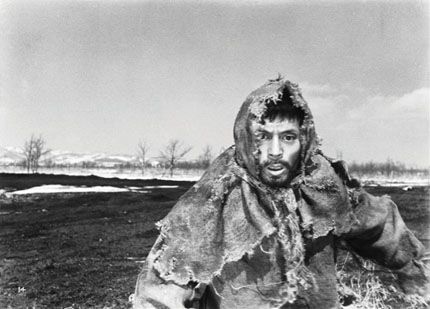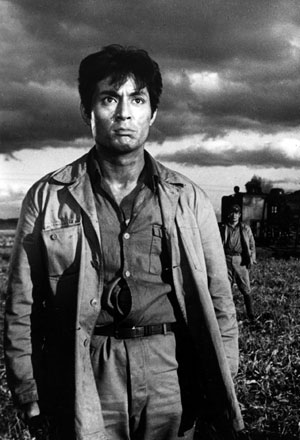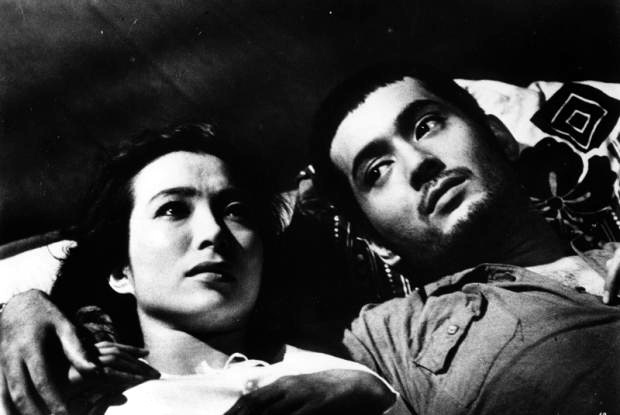 It's a crying shame that one of the great films of world cinema, Masaki Kobayashi's immortal World War II saga The Human Condition (1959 - 61, Shochiku Studios) is unavailable on DVD. US-based Image Entertainment had previously offered this epic nine-hour, three-film opus but has shamefully let it drop from their catalog. Film enthusiasts worldwide are the poorer for it.
It's a crying shame that one of the great films of world cinema, Masaki Kobayashi's immortal World War II saga The Human Condition (1959 - 61, Shochiku Studios) is unavailable on DVD. US-based Image Entertainment had previously offered this epic nine-hour, three-film opus but has shamefully let it drop from their catalog. Film enthusiasts worldwide are the poorer for it. The Human Condition trilogy follows the trials and tribulations of pacifist and conscientious objector Kaji (Tatsuya Nakadai) as he struggles to preserve his dignity and sanity amid the various horrors of enlisted service during World War II. In the first film, No Greater Love, Kaji is sent by his company to Japanese-controlled Manchuria where he witnesses the deplorable living conditions and suffering of Chinese slave laborers put under his charge. His attempts to treat these men with respect result in his being tortured, charged with conspiracy and sent to active duty. Part two, Road to Eternity, follows Kaji as he endures active duty (and the cruelty of his fellow officers) in the Imperial Japanese Army. In part three, A Soldier's Prayer, Kaji is captured and interned in a Siberian POW camp, eventually to escape into the frozen white wasteland ...
The Human Condition trilogy follows the trials and tribulations of pacifist and conscientious objector Kaji (Tatsuya Nakadai) as he struggles to preserve his dignity and sanity amid the various horrors of enlisted service during World War II. In the first film, No Greater Love, Kaji is sent by his company to Japanese-controlled Manchuria where he witnesses the deplorable living conditions and suffering of Chinese slave laborers put under his charge. His attempts to treat these men with respect result in his being tortured, charged with conspiracy and sent to active duty. Part two, Road to Eternity, follows Kaji as he endures active duty (and the cruelty of his fellow officers) in the Imperial Japanese Army. In part three, A Soldier's Prayer, Kaji is captured and interned in a Siberian POW camp, eventually to escape into the frozen white wasteland ... The character of Kaji is a stand-in for director Kobayashi, himself drafted in January of 1942. Unlike directors who would later become his contemporaries (like Akria Kurosawa), Kobayashi spent four years as a soldier in the hell that was WW II. The Human Condition is his passionate castigation of war and martial culture, and a revelation for anyone who thought the Japanese people supported the war en masse. Tatsuya Nakadai is devastating as Kaji, his large, soulful eyes communicating the earnest decency of his character, caught as he is in an impossible situation. Nakadai was discovered by Kobayashi, and the role of Kaji brought him to the world's attention for the stellar talent he is -- his performance is simply shattering.
The character of Kaji is a stand-in for director Kobayashi, himself drafted in January of 1942. Unlike directors who would later become his contemporaries (like Akria Kurosawa), Kobayashi spent four years as a soldier in the hell that was WW II. The Human Condition is his passionate castigation of war and martial culture, and a revelation for anyone who thought the Japanese people supported the war en masse. Tatsuya Nakadai is devastating as Kaji, his large, soulful eyes communicating the earnest decency of his character, caught as he is in an impossible situation. Nakadai was discovered by Kobayashi, and the role of Kaji brought him to the world's attention for the stellar talent he is -- his performance is simply shattering.The Human Condition is one of those films that should be seen by everyone. What a pity then, that it is unavailable on DVD to be seen by anyone.


